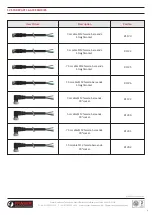
Fraser Anti-Static Techniques, Scotts Business Park, Bampton, Devon EX16 9DN, UK
T + 44 (0) 1398 331114 F + 44 (0) 1398 331411 E [email protected] W www.fraser-antistatic.com
7
NEOS 30 OEM-DM-Iss.2
7. PERFORMANCE
How does NEOS 30 OEM Compare to the Manual NEOS Settings?
The NEOS 30 OEM has slightly better performance to the M1, M2 and M3 manual settings on the standard NEOS 30.
This is because, although the frequencies may be similar, the NEOS 30 OEM changes gradually, not in steps of 0.5 Hz, 1.0 Hz, 1.5 Hz
etc. This fine tunes the performance for maximum efficiency as the distance changes.
The big difference, though, is that it changes automatically between these settings according to the distance signal from the PLC.
In this way it is always at its most powerful manual setting for the job.
The operator does not have to change the setting between different jobs to ensure optimal performance.
How does the performance of NEOS 30 OEM compare to the ‘intelligent’ AN and AL Settings?
This is more difficult to answer because the effectiveness of the AL and AN setting depends on the size of the charge – the bigger
the charge, the better the sensing.
We compared the performance of the NEOS 30 OEM and the standard ‘intelligent’ settings on our constant current charge plate
monitor. We used a plate voltage of 25 kV to represent a typical charge and used distances from 200 mm to 1.5 mm. The results
were:
•
AN setting was better than NEOS 30 OEM at distances up to 470 mm
•
AL setting was better at distances up to 625 mm
These results will vary with the size of the charge. However, the tests make it clear that at longer ranges, the NEOS 30 OEM will
give a better overall result.
Please remember that we can customise the performance to meet the particular requirements of the machine. The default setting
is for distances from 200 mm to 1500 mm. We can change this to meet the OEM`s machinery, for example:
If the distance changes from:
or
or
700 mm to 1500 mm
1100 mm to 500 mm
300 mm to 1400 mm to 300 mm























